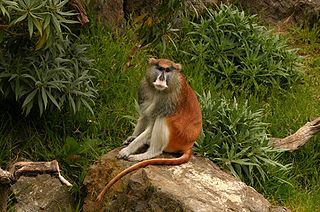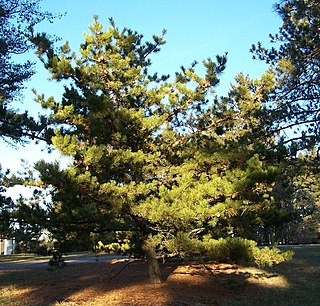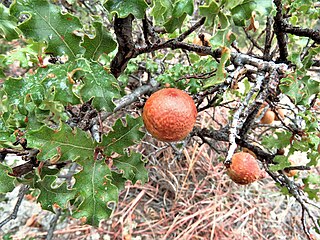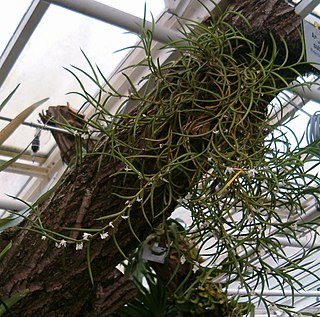
The International Union for Conservation of Nature (IUCN) Red List of Threatened Species, also known as the IUCN Red List or Red Data Book, founded in 1964, is an inventory of the global conservation status and extinction risk of biological species. A series of Regional Red Lists, which assess the risk of extinction to species within a political management unit, are also produced by countries and organizations.

Erythrocebus is a genus of Old World monkey. All three species in this genus are found in Africa, and are known as patas monkeys. While previously considered a monotypic genus containing just E. patas, a 2017 review argued that, based on morphological evidence and heavy geographic separation between taxa, E. patas should be split back into distinct species as recognised in the 19th century.

Table Mountain pine, Pinus pungens, also called hickory pine, prickly pine, or mountain pine, is a small pine native to the Appalachian Mountains in the United States.

The blue spruce, also commonly known as green spruce, Colorado spruce, or Colorado blue spruce, is a species of spruce tree native to North America in Arizona, Colorado, Idaho, New Mexico, Utah and Wyoming. It is noted for its blue-green colored needles, and has therefore been used as an ornamental tree in many places far beyond its native range.

The Ogilvie Mountains collared lemming is a species of rodent in the family Cricetidae. It is found only in Yukon Territory, Canada. Its natural habitat is tundra.
Western pebble-mound mouse or Ngadji is a burrowing and mound building rodent in the family Muridae. They occur in the Pilbara, a remote region in the northwest of Australia.

Myrcianthes pungens, the guabiyu, is a species of plant in the family Myrtaceae. It is native to Brazil and Uruguay.
Trichilia pungens is a species of plant in the family Meliaceae. It is endemic to Cuba.

Arctostaphylos pungens, with the common name pointleaf manzanita, is a species of manzanita. It is native to the Southwestern United States and to northern and central Mexico, where it grows in chaparral and woodland habitats, and on desert ridges. Arctostaphylos pungens can be seen growing at Tent Rocks National Monument in New Mexico at an elevation of about 6000 feet.

The World's 25 Most Endangered Primates is a list of highly endangered primate species selected and published by the International Union for Conservation of Nature (IUCN) Species Survival Commission (SSC) Primate Specialist Group (PSG), the International Primatological Society (IPS), Global Wildlife Conservation (GWC), and Bristol Zoological Society (BZS). The IUCN/SSC PSG worked with Conservation International (CI) to start the list in 2000, but in 2002, during the 19th Congress of the International Primatological Society, primatologists reviewed and debated the list, resulting in the 2002–2004 revision and the endorsement of the IPS. The publication was a joint project between the three conservation organizations until the 2012–2014 list when BZS was added as a publisher. The 2018–2020 list was the first time Conservation International was not among the publishers, replaced instead by GWC. The list has been revised every two years following the biannual Congress of the IPS. Starting with the 2004–2006 report, the title changed to "Primates in Peril: The World's 25 Most Endangered Primates". That same year, the list began to provide information about each species, including their conservation status and the threats they face in the wild. The species text is written in collaboration with experts from the field, with 60 people contributing to the 2006–2008 report and 85 people contributing to the 2008–2010 report. The 2004–2006 and 2006–2008 reports were published in the IUCN/SSC PSG journal Primate Conservation,, since then they have been published as independent publications.

Quercus pungens, commonly known as the sandpaper oak or scrub oak, is a North American species evergreen or sub-evergreen shrub or small tree in the white oak group. There is one recognised variety, Quercus pungens var. vaseyana, the Vasey shin oak. Sandpaper oak hybridizes with gray oak in the Guadalupe Mountains of New Mexico and Texas.
Quercus hinckleyi, commonly called Hinckley oak, is a rare species in the white oak group. It has a restricted range in the Chihuahuan Desert of the southwestern United States and northern Mexico. In the US, it occurs in only two counties in southwestern Texas and is federally listed as a threatened species.
Afropectinariella doratophylla is a species of orchid in the genus Afropectinariella that is endemic to São Tomé and Príncipe. On São Tomé, it can be found from elevations of 850–1,600 m (2,790–5,250 ft), growing with Syzygium guineense or with Bulbophyllum lizae. On Príncipe, it is found in shrubby vegetation at around 300 m (980 ft) elevation. It is threatened by deforestation for agriculture and timber.
Afropectinariella gabonensis is a species of Afropectinariella that can be found in Cameroon, the Democratic Republic of the Congo, Equatorial Guinea and Gabon.

Afropectinariella subulata is a species of Afropectinariella that can be found in Cameroon, the Democratic Republic of the Congo, Côte d'Ivoire, Equatorial Guinea, Gabon, Ghana, Guinea, Liberia, Nigeria and Sierra Leone. This species is found in lowland forests, especially those rich in Caesalpinioideae between 50 and 700 m elevation. It occurs in periodically inundated swampy forests with Raphia, Pandanus and Marantaceae, and on calcareous rock in shrubby vegetation. It has been recorded on high shaded branches of Gilbertiodendron dewevrei.

Afropectinariella is a genus of flowering plants belonging to the family Orchidaceae. All four of its current species were moved from the genus Angraecum.











